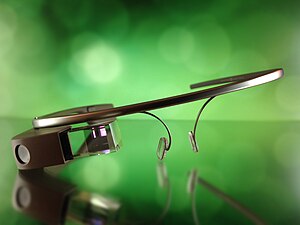Project Glass

Google Glass Explorer Edition
|
|
| Also known as | Project Glass |
|---|---|
| Developer | |
| Manufacturer | Foxconn |
| Type | Optical head-mounted display (OHMD), Wearable technology |
| Release date |
Developers (US): February 2013 Public (US): Around 2013 |
| Introductory price | Explorer version: $1,500 USD Standard edition: |
| Operating system | Glass OS (Google Xe Software) |
| CPU | OMAP 4430 System on a chip, dual-core processor |
| Memory | 2 GB RAM |
| Storage | 16 GB flash memory total (12 GB of usable memory) |
| Display | Prism projector, 640×360 pixels (equivalent of a 25 in/64 cm screen from 8 ft/2.4 m away) |
| Sound | Bone conduction transducer |
| Input | Voice command through microphone,accelerometer,gyroscope,magnetometer,ambient light sensor, proximity sensor |
| Controller input | Touchpad, MyGlass phone mobile app |
| Camera | 5 Megapixel photos 720p video |
| Connectivity | Wi-Fi 802.11b/g,Bluetooth,micro USB |
| Power | 570 mAh Internal lithium-ion battery |
| Weight | 36 g (1.27oz) |
| Backward compatibility |
Any Bluetooth-capable phone; MyGlass companion app requires Android 4.0.3 (Ice Cream Sandwich) or higher or any iOS 7.0 or higher |
| Related articles | Oculus Rift |
| Website | x.company/glass/ |
Google Glass was an optical head-mounted display designed in the shape of a pair of eyeglasses. It was developed by X (previously Google X) with the mission of producing a ubiquitous computer. Google Glass displayed information in a smartphone-like hands-free format. Wearers communicated with the Internet via natural language voice commands. Google started selling a prototype of Google Glass to qualified "Glass Explorers" in the US on April 15, 2013, for a limited period for $1,500, before it became available to the public on May 15, 2014. It also had a camera attached to it.
The headset originally received a great deal of criticism and legislative action due to privacy and safety concerns. On January 15, 2015, Google announced that it would stop producing the Google Glass prototype, to be continued in 2017 tentatively. In July 2017, it was announced that the Google Glass Enterprise Edition would be released.
Google Glass was developed by Google X, the facility within Google devoted to technological advancements such as driverless cars.
The Google Glass prototype resembled standard eyeglasses with the lens replaced by a head-up display. In mid-2011, Google engineered a prototype that weighed 8 pounds (3.6 kg); by 2013 they were lighter than the average pair of sunglasses.
In April 2013, the Explorer Edition was made available to Google I/O developers in the United States for $1,500.
The product was publicly announced in April 2012.Sergey Brin wore a prototype of the Glass to an April 5, 2012, Foundation Fighting Blindness event in San Francisco. In May 2012, Google demonstrated for the first time how Google Glass could be used to shoot videos.
Google provided four prescription frame choices for $225 and free with the purchase of any new Glass unit. Google entered in a partnership with the Italian eyewear company Luxottica, owners of the Ray-Ban, Oakley, and other brands, to offer additional frame designs. In June 2014, Nepal government adopted Google Glass for tackling poachers of wild animals and herbs of Chitwan International Park and other parks listed under World heritage sites. In January 2015, Google ended the beta period of Glass (the "Google Glass Explorer" program).
...
Wikipedia

